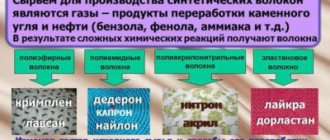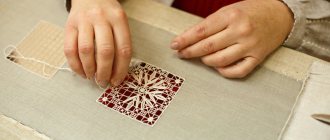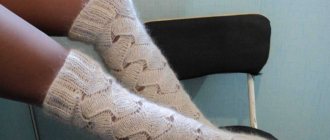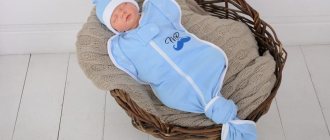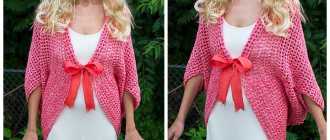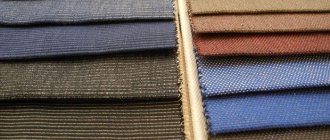Knitting enthusiasts have different opinions about acrylic yarn. Some people don’t like acrylic because of its unnatural origin and its tendency to form pellets on the surface of products. And others really like to work with acrylic yarn and wear things knitted from it. Adherents praise the material for its bright colors, ease of care and attractive appearance.
What it is?
Acrylic is a synthetic thread. Petroleum products are used for its production. Acrylic fiber is created through a process of complex chemical reactions under certain temperature influences.
In such a context, there is no point in going deeper into the description of the direct production process. It is much more interesting to understand what characteristics and properties this product has. Acrylic is usually called all polymer materials whose composition is based on methacrylic acid. But most often the word “acrylic” is found in the context of different types of yarn.
Acrylic fiber was first obtained by scientists in the mid-twentieth century in America. It is this country that is considered the birthplace of fibers of complex synthetic origin. The Americans began to master the new product, and soon the first variety appeared - the Orion material. Acrylic itself and this name originated in 1952.
Compound
The 100% acrylic yarn is produced through complex technical manipulations from hydrocyanic acid and acetylene isolated from natural gas. This is how 100% synthetic fibers are obtained. In production in different countries, the names of acrylic yarn differ: PAN, acrylan, camilon, ordon, dralon, kurtel and more.
Acrylic is also often called artificial wool due to the similarity of the properties of synthetic and wool fibers. In fact, the unnatural origin of acrylic does not mean that the material is full of disadvantages. It is worth finding out in more detail what the pros and cons of threads made from 100 percent synthetics and mixed yarn with its addition are.
Features of caring for acrylic items
- the water temperature when washing should not exceed 30oC-40oC;
- It is recommended to use gel detergents;
- if it is washed in a washing machine, then it is advisable to use the delicate mode or set the regulator to the “wool”, “synthetic” or “hand wash” mode;
- a cap of emollient will give the item aroma, softness and reduce the likelihood of pilling;
- It is recommended to soak acrylic items in warm water for 15-20 minutes;
- It is not recommended to steam acrylic products, dry them in a dryer or twist them;
- It is best to dry the product in a horizontal position, after straightening it and giving it its original shape;
- avoid exposure to direct sunlight;
All these small recommendations will help you enjoy acrylic yarn from TVU Garnvertrieb GmbH. After your first purchase of this yarn, you will fall in love with it once and for all. "Made in Germany" gives a full guarantee of 100% quality.
Advantages and disadvantages
It is recommended to start learning knitting with synthetic acrylic threads, since it is easier to learn to knit. In the hands of beginners, such yarn is less likely to tangle and slip off the knitting needles.
The loops are more accurate, and the fabric is denser and smoother. In addition, the products are bright and impressive, and the material can be purchased at an affordable price.
Items knitted from acrylic yarn:
- do not shrink during washing;
- do not lose shape during wear;
- pellets do not form on high-quality material, but if this happens, you can simply purchase a machine to remove them;
- the yarn does not fade and can be easily dyed in production;
- products made from synthetic yarn dry quite quickly, especially if you spin them at low speeds in a washing machine;
- the contact of the material with the skin leaves a pleasant sensation;
- the material is resistant to fading;
- does not cause allergies, which is why acrylic is often used to knit children’s wardrobe items and toys for the little ones;
- Synthetic fiber has greater strength compared to simple wool, so items made from acrylic wool are as wearable and durable as possible;
- affordable price for skeins of yarn is a clear advantage over analogues for handicrafts;
- the fiber is easily dyed, which makes it possible to produce threads of various shades;
- things made of acrylic do not fade;
- acrylic products do not wrinkle, for which they are highly valued by travelers - this allows you to look fresh and neat in any situation;
- the material is very pleasant to the touch, soft when in contact with the skin, warms the body;
- resistant to adverse weather conditions, acids and solvents, dry cleaning;
- poor hygroscopicity can be considered an advantage - if you accidentally spill coffee or juice, there will be no stains left on acrylic items (if there is a mark, it will be unstable, there is no need to dry clean the item);
- synthetics are not to the taste of moths, which allows you not to worry about the item when it is stored for a long time in the closet.
Let's look at the negative properties of 100% acrylic.
Even those qualities that do not suit one person may not interfere at all and may even be liked by another. Everything is individual, and you just need to study everything before purchasing yarn or an item made from acrylic yarn:
- low-quality yarn may pill;
- accumulates static voltage and becomes electrified;
- synthetics have poor hygroscopicity;
- when exposed to bright light, acrylic thread may become stiffer;
- artificial material absorbs fat and is more difficult to wash;
- the item is blown by the wind if the knitting is loose;
- Synthetics have low breathability, people with increased secretion of sweat glands often complain that they sweat more in synthetic things;
- 100% synthetic acrylic threads are not suitable for making socks, as they will wear off very quickly.
Acrylic yarn - strength, lightness, elasticity
It is difficult for an inexperienced eye to distinguish acrylic yarn from wool yarn, especially in finished products, although acrylic is a completely artificial, synthetic material obtained from natural gas. It is believed that for beginners learning the basics of knitting, the most suitable yarn is acrylic; such yarn can be used for both knitting and crocheting.
Sometimes it happens that our compatriots do not find the words “acrylic yarn” on the packaging that they intended to buy. This happens because acrylic fiber is designated differently on labels from different countries:
• PAN fiber, acrylic (Russia); • acrylan, orlon, (USA); • courtel (England); • dralon (Germany); • cashmilon (Japan); as well as redon, nitron, prelana, krilor. When you see such designations on labels, keep in mind that this is acrylic yarn. The properties of this synthetic fiber (strength, lightness, elasticity) make yarn from it suitable for knitting any products that do not fade in the sun, and if we are talking about knitted acrylic clothes, it does not cause allergic reactions and is pleasant to the touch. Acrylic yarn is easily dyed in any color, and modern dyeing technologies make it possible to give the yarn a glossy or matte tone.
Acrylic yarn is perfectly knitted both on knitting machines, household and industrial, and by hand. In general, according to experienced needlewomen, knitting from acrylic yarn does not require any special skill and is even easier than from wool or cotton yarn, since acrylic threads are perfectly even in thickness. Well, if it happens that, due to inexperience, you ruin something made from acrylic yarn, the loss is not so great, acrylic is much cheaper than wool or cotton, not to mention alpaca or silk.
As a material for knitting, “100% acrylic” yarn is most often used; this is, for example, the Pekhorka Beaded yarn available in our store’s assortment. You can also achieve good results by using mixtures of acrylic with wool, mohair or other natural materials for knitting. Warm and comfortable items made from such mixed yarn fall less often and look very decorative.
Thin acrylic yarn deserves a separate discussion. It allows the needlewoman to fully use the wonderful opportunities that this yarn - acrylic - provides. You can also buy thin acrylic yarn, for example VITA Crystal, in our store. A swimsuit or an original top made of the finest acrylic threads can make its owner the queen of the beach!
Children's acrylic yarn is widely used in needlework. One of the reasons is the low price of such yarn, because it is impractical for children to knit expensive things - they quickly outgrow them. In addition to clothing for children, acrylic yarn is used to knit rugs, blankets, napkins, and toys. Here, special mention should be made of amigurumi - knitted miniature toys, very popular recently among needlewomen, the fashion for which came from Japan. Amigurumi characters are usually funny figures of animals and people. At home, in the Land of the Rising Sun, and now here too, amigurumi is most often made from acrylic yarn. For example, from yarn Pekhorka Children's novelty, VITA BABY, Alize Sekerim Bebe - all these items are sold in our online store.
A couple of useful tips:
• products made from acrylic yarn are not recommended to be steamed;
• use only good quality acrylic yarn from reputable manufacturers. Products made from low-quality acrylic yarn may stretch greatly after washing and become unsuitable for wear.
Kinds
The ideal option for many is blended yarn, which consists not only of acrylic, but also of additional natural fibers. Such threads embody all the positive qualities that are expected from yarn for knitting garments. Acrylic gives the thread elasticity and softness, making its color resistant to fading and fading. As a result, the item is more durable and wearable.
The presence of natural fibers in the composition allows the product to “breathe”, absorb moisture and ensure good heat transfer.
In multicomponent acrylic fibers, up to 5-10% is added. In combination with pure wool or cotton it can be 35% or more. In this tandem, the product manages to impart all the positive qualities that are especially felt during the use of knitted clothing. The item turns out soft, voluminous, durable and resistant to deformation when caring for it.
Acrylic with wool is one of the most popular types of yarn for knitting items for cold weather. It is equally good for both adults and children. Wool itself provides excellent warmth, but, unfortunately, it has a prickly structure. This causes discomfort when touching the skin, especially when it comes to children. The addition of acrylic to the blended yarn gives the thread a silky texture and the missing softness.
In addition, thanks to acrylic, pellets do not form on the surface of the product. At the same time, the item remains as warm as if it were made of pure wool thread. Even if the thread used is not very thick.
Mohair and acrylic fiber also complement each other perfectly. The properties of goat down do not allow the use of mohair yarn without additives. It is never 100% mohair; it always contains synthetic fiber. Acrylic gives it the missing strength, but does not at all impair the properties of soft natural wool.
With melange. Synthetics are also present in melange yarn. This option is often chosen to create knitted children's products.
Cotton with acrylic. This is the perfect combination for knitted summer items. 100% cotton has good qualities, but very high density, which makes the product heavier. Because of this, it takes a very long time to dry after washing and can even shrink significantly. High-volume acrylic gives natural cotton thread lightness and adds gloss, allowing the openwork knitting to be “airy”. Cotton yarn with acrylic holds its shape well.
The range of acrylic yarn is represented by a wide variety of fluffiness, in combination with additional fibers, thickness, color, density and twist of the fibers.
Myth #1: Acrylic cannot be blocked.
Interlocking is the process of applying moisture and heat to a finished product to “fix” its shape. And of course, everyone who tried, out of habit, to block acrylic items with an iron, ended up with a loss of volume: the item became “rag-like.” Because of this, the myth arose that the material cannot be blocked.
In fact, blocking acrylic is not only possible, but also necessary - just take into account the specifics of the material. When blocking you need to use steam, so the technology is a little different from the usual one. Briefly:
- secure the parts of the product with plastic or stainless steel pins;
- turn the iron on to steam mode. Without touching the product, steam its surface;
- let the product dry.
Your product is fixed! Moreover, the procedure is needed only once, immediately after completion of the work. After washing, the item will not stretch and will retain its shape.
Where is it used?
Acrylic fibers are most often used in the manufacture of fabrics and yarns. They soften the natural fibers of wool, making them softer and more pleasant to wear. In addition, they help maintain the color of finished products and prevent shrinkage.
Synthetic acrylic yarn without additives is rarely chosen, although it is found everywhere in stores. More often they knit and crochet from mixed yarn of 2-3 components, including acrylic.
The thickness of acrylic yarn can be varied. Each manufacturer has skeins of thin thread and thicker ones, including fashionable voluminous options. Accordingly, the choice of product that can be knitted from them is limited only by your own imagination.
Multi-component yarn makes excellent items for babies , since the thread does not cause irritation, is gentle, and is inexpensive. This is practical because children grow very quickly. This yarn is also suitable for knitting toys. They are bright and inexpensive, easy to wash and dry quickly.
Bulky threads can make a spectacular knitted blanket that will last a long time. As well as decorative pillowcases, potholders, lampshades and other decorative elements. Acrylic threads are often used to create stylish jewelry: beads, bracelets, brooches and more. Sweaters and sweaters made from mixed yarn will please people with allergies to woolen products.
Advantages of acrylic yarn
First of all this:
- strength;
- high wear resistance;
- no allergens.
In addition, acrylic is easily dyed , so the color range of the yarn is presented in all sorts of colors and shades. You can personally order the color of yarn you need from the manufacturer.
Another huge advantage of acrylic yarn is its low price, although the price range can vary quite significantly. It all depends on the purpose of its use. For example, Karachay yarn is not suitable for knitting delicate booties for a newborn baby. But using high-quality acrylic yarn from Germany , you can create a surprisingly soft, delicate and beautiful product.
Recommendations for product care
Items made from acrylic or blended yarn should not be ironed with a hot iron. High temperatures destroy the structure of synthetic fibers. It is advisable to iron through damp gauze using a suitable mode. The iron must be warm.
Wash only on a delicate cycle or on a program for synthetic fabrics . Ideally, hand wash.
It is recommended to add a rinse aid or antistatic agent to relieve static tension.
Spin - only at low speeds. It’s better not to wring it out in the machine at all, but to use a terry towel to absorb excess moisture.
Dry the item on a flat surface, giving it the desired shape. On a radiator or near a heating device, the product may lose volume and elasticity.
Acrylic yarn has many positive qualities, which allows you to take a creative approach to creating knitted items. If you know the features of this material, then knitting and using finished products will bring only pleasant emotions.
Disadvantages of acrylic yarn
- Very low ability to absorb and release moisture - hygroscopicity.
- Low air permeability and vapor conductivity.
- High ability to electrify.
Therefore, before knitting something from acrylic, you need to remember these features. If you want to knit something that will touch your skin, you should choose a yarn made from natural fibers, such as cotton. But if you decide to treat yourself to a knitted blanket, scarf, jacket, then acrylic yarn will be your ally! And remember, hygroscopicity is an important indicator for underwear, summer and children's clothes. If you do not neglect our recommendations and take proper care of acrylic items, they will delight you for many seasons.
